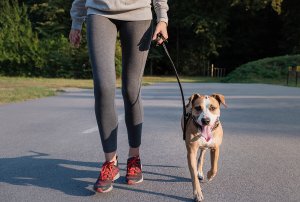5 Tips to go Jogging with your Dog

Warm days are here to stay! You may have noticed that both you and your pet have gained some pounds over the wintertime? Or you may also be a running fan and want to “convert” everyone around you? In this article, we’ll give you some tips so you can go jogging with your dog while still keeping your furry friend happy and safe.
Go jogging with your dog: guaranteed fun exercise
Did you know that people who exercise with their pets are more likely to avoid a sedentary lifestyle? And on top of that, physical activity is very good for animals. As long as it’s done in moderation and gradually increasing intensity.
If you want to go jogging with your dog but you’ve never done this before because of lack of knowledge or other preconceptions, here are some tips. Enjoy your favorite sport alongside your furry best friend!
1. Consult the veterinarian
Without a doubt, consulting your trusted vet is the first step before going jogging with your dog. A health professional will make sure your pet is in good health and ready to exercise. In order to assert their overall health, the vet will do some routine tests and recommend when and how you can exercise with your dog.
Also, you have to keep in mind that a puppy is not the same as an adult dog. Young pups have different needs and abilities than older dogs. Thus, it’s important to adapt your chosen exercise to your dog’s age and physical condition.
Your vet will probably offer insightful advice about letting Fido come with you in your daily run.

2. Analyze your dog
You may think that any dog has the ability to run, but in reality, this isn’t always the case. Beyond an issue of age – as we said in the previous paragraph – the truth is that certain breeds are more athletic than others. Equally, each breed has certain characteristics that make them better suited to engage in vigorous sports.
For example, dogs with an elongated snout and long legs – such as an Afghan greyhound or a Dalmatian – often get along very well with exercise. The same doesn’t happen with brachycephalic dog breeds or those that have shorter legs. Brachycephalic dogs have a flat snout, and usually, this also involves difficulty breathing during strenuous activities.
So, if you have a bulldog, a pug or a Pekinese, avoid very demanding exercises. And if your pet is overweight, or is prone to musculoskeletal issues such as Labradors, it’s best to pay close attention to their effort. This will ensure that they stay safe and healthy at all times.
3. Buy a special leash
It doesn’t matter if you go jogging with your dog in the park, on the beach or in the mountains, your pup should always be on a leash. As obedient as they may be, there’s always the possibility of seeing an animal or perceiving something strange that leads to running.
In those cases, a leash can prevent your four-legged friend from getting hurt. There are special leashes designed for running that aren’t the same as those used for quiet walks around the city.
We recommend a flexible and long leash of about seven feet long that should be attached to your waist and the dog’s waist through a harness. This type of anchor is much safer than holding the leash with your hand, but both you and your dog will need to become used to it!
To make the transition to the new leash easier, try to practice going around with it on some of your daily walks. It’ll be a great opportunity to get used to this new way of walking together.
4. Choose the best place to go jogging with your dog
Unlike people, dogs don’t have sports shoes that adapt to different types of soil. However, animals and human beings do agree on one thing: it’s easier and softer on our joints to run on land than on asphalt.
When running with your pet, it’s important to remember that their pads are very sensitive to heat. Therefore, it’s not recommended that they exercise in the hottest hours. This might mean pushing your daily run from your lunch hour to a later time in the day when the sun is less bright and the floor won’t burn your dog’s paws.

You should also pay close attention when running in natural spaces: although grass and dirt might seem a better idea, splinters and stones can hurt your dog’s feet. To avoid any issues, make sure you check their paws after your daily run. If something hurts you can take them to the vet to get it looked at.
On the other hand, you should choose places where you’re completely sure that you’re allowed to run with pets, even while on a leash. Even better if you choose a well-designated area with roads in good condition for both humans and pets. Choosing the right place to jog with your dog can be a decisive factor to make exercising easier.
5. Go slow at first
If you’ve ever wanted to go jogging with your dog, it’s common to want to do it all too fast. Your pet will probably give up sooner rather than later if on the very first day you plan to run ten miles. Dogs, just like humans, need proper training before committing to strenuous exercise!
You should gradually get your dog used to getting more exercise. If you’re already in fairly good physical condition, this might mean that you can’t really make Fido go with you throughout your whole workout.
It’s better if you start with a light walk at first and over time you can gradually add complexity to the exercise. Then, you can start going on longer walks of around one to three miles. Then, when you see that the animal doesn’t get too tired, you can finally start running.
Finally, we advise that you bring water for both you and your pet, take several breaks every so often and avoid copious meals a few hours before exercise. With all these tips, you and your four-legged friend will be having fun and enjoying the warm weather in no time!
Warm days are here to stay! You may have noticed that both you and your pet have gained some pounds over the wintertime? Or you may also be a running fan and want to “convert” everyone around you? In this article, we’ll give you some tips so you can go jogging with your dog while still keeping your furry friend happy and safe.
Go jogging with your dog: guaranteed fun exercise
Did you know that people who exercise with their pets are more likely to avoid a sedentary lifestyle? And on top of that, physical activity is very good for animals. As long as it’s done in moderation and gradually increasing intensity.
If you want to go jogging with your dog but you’ve never done this before because of lack of knowledge or other preconceptions, here are some tips. Enjoy your favorite sport alongside your furry best friend!
1. Consult the veterinarian
Without a doubt, consulting your trusted vet is the first step before going jogging with your dog. A health professional will make sure your pet is in good health and ready to exercise. In order to assert their overall health, the vet will do some routine tests and recommend when and how you can exercise with your dog.
Also, you have to keep in mind that a puppy is not the same as an adult dog. Young pups have different needs and abilities than older dogs. Thus, it’s important to adapt your chosen exercise to your dog’s age and physical condition.
Your vet will probably offer insightful advice about letting Fido come with you in your daily run.

2. Analyze your dog
You may think that any dog has the ability to run, but in reality, this isn’t always the case. Beyond an issue of age – as we said in the previous paragraph – the truth is that certain breeds are more athletic than others. Equally, each breed has certain characteristics that make them better suited to engage in vigorous sports.
For example, dogs with an elongated snout and long legs – such as an Afghan greyhound or a Dalmatian – often get along very well with exercise. The same doesn’t happen with brachycephalic dog breeds or those that have shorter legs. Brachycephalic dogs have a flat snout, and usually, this also involves difficulty breathing during strenuous activities.
So, if you have a bulldog, a pug or a Pekinese, avoid very demanding exercises. And if your pet is overweight, or is prone to musculoskeletal issues such as Labradors, it’s best to pay close attention to their effort. This will ensure that they stay safe and healthy at all times.
3. Buy a special leash
It doesn’t matter if you go jogging with your dog in the park, on the beach or in the mountains, your pup should always be on a leash. As obedient as they may be, there’s always the possibility of seeing an animal or perceiving something strange that leads to running.
In those cases, a leash can prevent your four-legged friend from getting hurt. There are special leashes designed for running that aren’t the same as those used for quiet walks around the city.
We recommend a flexible and long leash of about seven feet long that should be attached to your waist and the dog’s waist through a harness. This type of anchor is much safer than holding the leash with your hand, but both you and your dog will need to become used to it!
To make the transition to the new leash easier, try to practice going around with it on some of your daily walks. It’ll be a great opportunity to get used to this new way of walking together.
4. Choose the best place to go jogging with your dog
Unlike people, dogs don’t have sports shoes that adapt to different types of soil. However, animals and human beings do agree on one thing: it’s easier and softer on our joints to run on land than on asphalt.
When running with your pet, it’s important to remember that their pads are very sensitive to heat. Therefore, it’s not recommended that they exercise in the hottest hours. This might mean pushing your daily run from your lunch hour to a later time in the day when the sun is less bright and the floor won’t burn your dog’s paws.

You should also pay close attention when running in natural spaces: although grass and dirt might seem a better idea, splinters and stones can hurt your dog’s feet. To avoid any issues, make sure you check their paws after your daily run. If something hurts you can take them to the vet to get it looked at.
On the other hand, you should choose places where you’re completely sure that you’re allowed to run with pets, even while on a leash. Even better if you choose a well-designated area with roads in good condition for both humans and pets. Choosing the right place to jog with your dog can be a decisive factor to make exercising easier.
5. Go slow at first
If you’ve ever wanted to go jogging with your dog, it’s common to want to do it all too fast. Your pet will probably give up sooner rather than later if on the very first day you plan to run ten miles. Dogs, just like humans, need proper training before committing to strenuous exercise!
You should gradually get your dog used to getting more exercise. If you’re already in fairly good physical condition, this might mean that you can’t really make Fido go with you throughout your whole workout.
It’s better if you start with a light walk at first and over time you can gradually add complexity to the exercise. Then, you can start going on longer walks of around one to three miles. Then, when you see that the animal doesn’t get too tired, you can finally start running.
Finally, we advise that you bring water for both you and your pet, take several breaks every so often and avoid copious meals a few hours before exercise. With all these tips, you and your four-legged friend will be having fun and enjoying the warm weather in no time!
All cited sources were thoroughly reviewed by our team to ensure their quality, reliability, currency, and validity. The bibliography of this article was considered reliable and of academic or scientific accuracy.
- Curb, L. A., Abramson, C. I., Grice, J. W., & Kennison, S. M. (2013). The relationship between personality match and pet satisfaction among dog owners. Anthrozoos. https://doi.org/10.2752/175303713X13697429463673
This text is provided for informational purposes only and does not replace consultation with a professional. If in doubt, consult your specialist.








